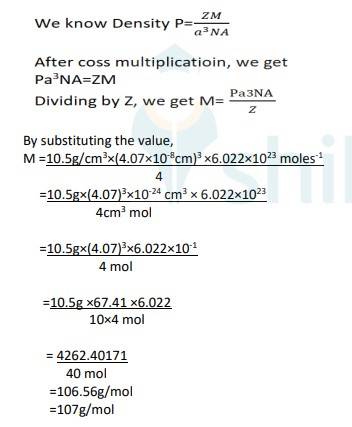Ncert Solutions Chemistry Class 12th
Get insights from 2.6k questions on Ncert Solutions Chemistry Class 12th, answered by students, alumni, and experts. You may also ask and answer any question you like about Ncert Solutions Chemistry Class 12th
Follow Ask QuestionQuestions
Discussions
Active Users
Followers
New answer posted
6 months agoContributor-Level 10
1.41 These solids have conductive in the intermediate range from 10−6 to 104ohm−1m−1. As there is rise in
the temperature, conductivity also increases because electrons from the valence band jump to
conduction band.
Types of semiconductors
(a) n - type semiconductor when silicon or germanium crystal is doped with group 15 element like P or
As, the dopant atom forms four covalent bonds like a Si or Ge atom but the fifth electron no used in
bonding, becomes delocalised and contribute its share towards electrical conduction. Thus, silicon or
germanium doped with P or As is called n-type semiconductor (negative
New answer posted
6 months agoContributor-Level 10
Analysis shows that nickel oxide has the formula Ni0.98 O1.00. What fractions of nickel exist as Ni2+ and Ni3+ ions?
1.40 It is given that nickel oxide has the formula as Ni0.98 O1.00.
As per the formula, there are 98 Ni ions for 100 oxide ions.
Out of 98 Ni ions, let x ions be in +2 oxidation state
98−x ions will be in +3 oxidation state.
Oxide ion has −2 charge.
To maintain electrical neutrality, total positive charge on cations = total negative charge on anions.
2x+3(98−x)+100(−2)=0
x=94
Fraction of Ni2+ ions = 94/98 = 0.96
Fraction of Ni2+ ions = 98-94/98 = 0.04
Hence, the fractions of nickel that exists as Ni2+ and Ni3+ are 0.
New answer posted
6 months agoContributor-Level 10
Analysis shows that nickel oxide has the formula Ni0.98 O1.00. What fractions of nickel exist as Ni2+ and Ni3+ ions?
1.41 It is given that nickel oxide has the formula as Ni0.98 O1.00.
As per the formula, there are 98 Ni ions for 100 oxide ions.
Out of 98 Ni ions, let x ions be in +2 oxidation state
98? x ions will be in +3 oxidation state.
Oxide ion has ?2 charge.
To maintain electrical neutrality, total positive charge on cations = total negative charge on anions.
2x+3 (98? x)+100 (?2)=0
x=94
Fraction of Ni2+ ions = 94/98 = 0.96
Fraction of Ni2+ ions = 98-94/98 = 0.04
Hence, the fractions of nickel that exists as Ni2+ and Ni3+ are 0.96 a
New question posted
6 months agoNew answer posted
6 months agoContributor-Level 10
1.38 We apply pythagoras theorem AC2= AB2+ BC2
(2R)2= (R+r)2 +(R+r)2 = 2(R+r)2
4R2 = 2(R+r)2
(2R)2= (R+r)2
√2(R)2= √(R+r)2 = √2r = R+r
r = √2 R – R
r = (√2-1) R
r = (1.4114-1)R
r= 0.414 R
New answer posted
6 months agoContributor-Level 10
1.37 Calculation of edge length of unit cell(a)
Atomic mass of the element (M)= 93g mol−1
Number of particles in bcc type unit cell (Z) = 2
Mass of the unit cell = Z * MNA = 2 * (93 g mol−1) (6.022*1023mol−1)
=30.89*10−23g
Density of unit cell (d) =8.55 g cm−3
Volume of unit cell (a3)=Mass of unit cell
Density of unit cell=(30.89*10−23g)(8.55 g cm−3)
=36.16*10−24cm3
Edge length of unit cell (a) = (36.13*10−24cm3)13
=3.31 * 10−8cm
Step II: Calculation of radius of unit cell (r)
For bcc structure, r=√3a4
=√3*(3.31*10−8cm)4
=1.43*10−8cm
New answer posted
6 months agoContributor-Level 10
1.36 It is given that the atoms of Q are present at the corners of the cube.
Therefore, number of atoms of Q in one unit cell = 8 x 1/8 = 1
It is also given that the atoms of P are present at the body-centre.
Therefore, number of atoms of P in one unit cell = 1
This means that the ratio of the number of P atoms to the number of Q atoms, P:Q = 1:1
Hence, the formula of the compound is PQ.
The coordination number of both P and Q is 8.
New answer posted
6 months agoContributor-Level 10
1.35 P= density
A= edge length of the cell
NA= Avogadro Number
Z= no. of atoms in F.C.C unit cell
M= mass of the metal
Edge length of the cell = d = 4.07*10-8 cm
Density = P =10.5g/cm3
No. of unit cell of face centered cubic (F.C.C) lattice is 4, Z=4
Avogadro Number (NA) = 6.022*1023
Mass of silver = M=?

New question posted
6 months agoNew answer posted
6 months agoContributor-Level 10
1.34 (i) The efficiency of packing in case of simple cubic unit cell is given below:
A simple cubic unit cell contains one atom per unit cell.
Also, a=2r, where a is the edge length and r is the radius of atom. Total volume of unit cell = a3
Packing efficiency = Volume of one sphere / Total volume of unit cell * 100
Packing Effieciency = 4/3πr3 / 8r3 X 100 = 52.4%
(ii) The efficiency of packing in case of body-centred cubic unit cell is given below:
A body-centred cubic unit cell containstwo atoms per unit cell.
Also, √3a = 4r,where a isthe edge length and r isthe radius of atom.
Total volume of unit cell = a3
Packing efficiency = Volu
Taking an Exam? Selecting a College?
Get authentic answers from experts, students and alumni that you won't find anywhere else
Sign Up on ShikshaOn Shiksha, get access to
- 65k Colleges
- 1.2k Exams
- 679k Reviews
- 1800k Answers
